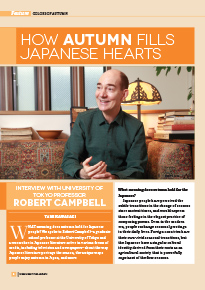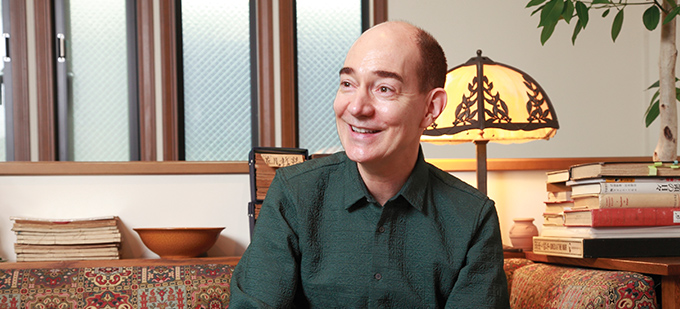Home > Highlighting JAPAN >Highlighting Japan November 2015>Colors of Autumn
Highlighting JAPAN

Colors of Autumn
How Autumn Fills Japanese Hearts
Interview with University of Tokyo Professor
Robert Campbell
Robert Campbell
What meaning does autumn hold for Japanese people? We spoke to Robert Campbell—a graduate school professor at the University of Tokyo and a researcher in Japanese literature active in various forms of media, including television and newspapers—about the way Japanese literature portrays the season, the unique ways people enjoy autumn in Japan, and more.

What meaning does autumn hold for the Japanese?
Japanese people have perceived the subtle transitions in the change of seasons since ancient times, and would express those feelings in the elegant practice of composing poems. Even in the modern era, people exchange seasonal greetings in their daily lives. Foreign countries have their own vivid seasonal transitions, but the Japanese have a singular cultural identity derived from their roots as an agricultural society that is powerfully cognizant of the four seasons.
Perhaps because one can palpably sense a release from the severe weather of summer and winter, respectively, autumn and spring bring a prolific outpouring of tanka and haiku poems. Autumn in particular frees us from summer’s hot and humid conditions and ushers in abundant harvests and music, as well as changes in wardrobe, and is a highly aesthetic season that requires the most of our five senses. After the burning heat of summer, life gradually withers and declines, welcoming the season of sleep that begins in autumn. Because we perceive this evanescence, we crave human warmth and contact. And that might be why in the autumn we feel the need to write letters, meet with old friends and share meals together, and enjoy outings.
Please tell us about some uniquely Japanese autumn customs.
From a Japanese person’s perspective, autumn begins after the Obon holidays in the middle of August. Obon is a spiritual event in Japan when the souls of ancestors return to this world and are welcomed back for a few days until they once again depart. It is said that, after experiencing this period and transitioning into autumn, people get a sense of their own existence within the passage of time as it flows from the past to the present, making this a season of high spirituality.
In October, when the rice is harvested, there are festivals held all throughout the country. People come together at these celebrations to give thanks for a good harvest, drinking heartily and singing songs. Festival music, while cheerful, also contains a certain loneliness, which may be attributed to a Buddhist sense of transience and impermanence. In these festivals and Obon dances, which generate a sense of unity and solidarity, one can feel the spirituality of the Japanese people as they share these precious moments.
Tell us about the elegance of Japanese autumn as depicted in Japanese literature.
Autumn is clearly a season that is richly portrayed in Japanese classical literature. For example, in the description of the autumn garden in The Tale of Genji, there are elements of gaiety and eroticism within loneliness, as well as a sense of deep contemplation and admiration toward the Imperial Court culture. And against the backdrop of the Suma Sea in autumn, feelings of desolation and conflict are expressed in great detail.
In the modern era, the sentiments of the characters “Sensei” and “I” [the narrator] in Natsume Sōseki’s novel Kokoro are dispassionately depicted while they make a graveyard visit, creating a deeply memorable portrayal of autumn. In Japanese novels it is quite common to find descriptions of the sky inserted into the story to reveal a mood. In the present day, Haruki Murakami’s Norwegian Wood contains an account of a thin, transparent autumn sky, which seems to reverberate with the thoughts and feelings of the characters living on the Earth below.
What are some unique ways of enjoying autumn in Japan?
Autumn is a season for harvesting rice. Rice is a staple food for Japanese and because new rice is so delicious, no other ingredients are necessary. A meal of only rice and autumn salmon is a feast in itself. You can also go out with friends to eat seasonal foods, enjoy the autumn leaves and hot springs, or stay at home and grill delicious fish or steam matsutake mushrooms in an earthenware pot. Or perhaps curl up with a new book and drink freshly brewed sake, and savor the ever-longer nights.
The appeals of autumn in Japan lie in relishing the stimulation of all five sensory organs. Seasonal flavors and aromas, flourishing over many years, prompt us to marvel at how beautiful something is, how fragrant, or how delicious. Time and space appeal to our senses. I believe that Japanese people become more expressive, and more open and friendly in their conversation, in autumn. Autumn is my favorite season in Japan.
© 2009 Cabinet Office, Government of Japan






